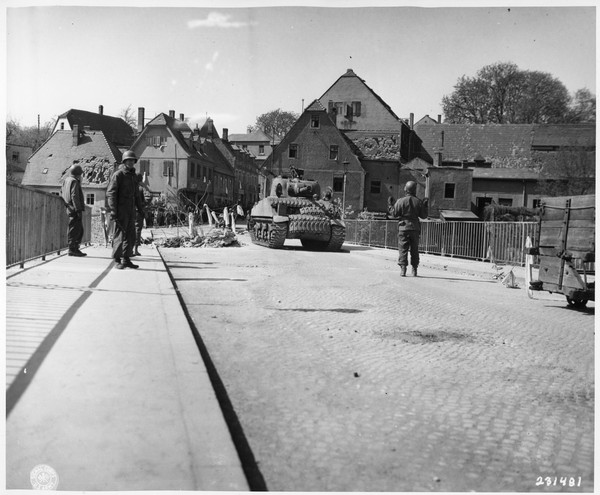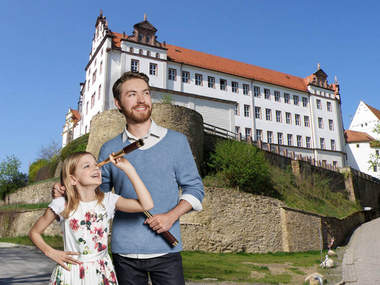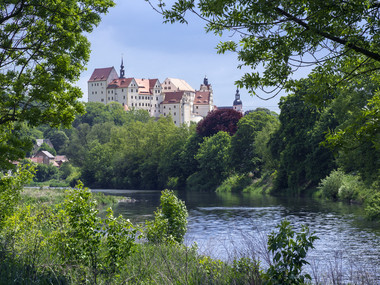Review: Speech by David Ray, former head of the Colditz Society and the British Veterans Association on the 70th anniversary of the liberation of Colditz Castle on 16 April 2015
Through the early months of 1945 the inmates of Oflag IVC, Colditz Castle discussed how it would all end. Would it be the Americans or the Soviets who got here first? Would the prisoners be forced out and marched away before liberty beckoned? Would they survive the end of the war? Friday 13th is an unlucky day in Britain. In the early hours of that morning the Prominente were driven off by guards but to who knew where. Kommandant Oberst Prawitt was given the order “Zerstorung – Raumung”, Destroy – Evacuate. Colonel Tod, Senior British Officer, refused to move. You have to feel some sympathy for Prawitt. The OKW said he would answer with his life if any Prominente escaped and Tod told him he would be tried and probably shot by the Allies if any harm came to them. Prawitt backed down. Prisoners in solitary confinement were released; this included an American Colonel under the death penalty. The prisoners took control of the armoury, the sentries remained at their posts with empty rifles and the keys of the camp were handed over to the SBO.
The defenders of Colditz tried to blow up the Mulde bridge but only partially succeeded. Overnight of 14th - 15th Hauptmann Eggers, the Security officer, burnt all the records and any incriminating material in the museum. It's hard today to imagine, next morning, Sherman tanks appearing out of Hohnbach and US Thunderbolts roaring over the castle with one flying below the level of the prisoners as they viewed out of the top floor windows. There was an interesting age range in the vicinity that day. Some of the German defenders were fourteen and fifteen year olds, several of the US Infantry were eighteen and nineteen, most of the prisoners were in their twenties and thirties while the camp guards were predominantly in the fifty to sixty five age bracket. The battle for Colditz was short but fierce. Several Americans were killed, including three experienced platoon sergeants. German casualties were high and the town was heavily damaged. The only guard company fatality was Feldwebel Baer who was killed by a shell just south of the castle. Flags appeared; white ones from house windows and the French Tricolour and Union flag from the top windows on the western side of the castle. This saved the castle from a major bombardment.
The morning of 16th broke to an eerie calm. The German defenders had moved out overnight. On that cold, bright day three camps in the town were liberated. GIs entered the castle around 10am to find the place already in Allied hands. There was uproar as the prisoners, some of whom had been incarcerated here for four and a half years, finally tasted freedom. One said it was like being re-born. The British shook the hands of their liberator; the French tried to kiss them on the cheek. The prisoners of war were taken aback by the comparison between the fit, well-armed, battle grimy men in their Martian-like combat suits and the gaunt, pale prisoners in their threadbare uniforms. The prisoners were also surprised by the rough way the Americans handled the Germans. “Any of these guys you want taken outside and dealt with”? An extremely attractive
US female war correspondent strode into the inner yard. The former prisoners could only gawp. The glider was assembled below the attic and a radio receiver was brought down from its hide and worked in the courtyard. The former guards could only gawp. They were alive, free and with Allies who spoke English. What a feeling it must have been.
Three days later the Colditz contingent were all safely back in the United Kingdom.
Special events around the 80th anniversary of the liberation
Historical film lecture by Christoph Kaufmann: Liberation in motion. Films from American archives

16 April 2025 marks the 80th anniversary of the liberation of Colditz Castle by American troops.
With this film presentation, we want to remember what happened in April 80 years ago. The day of liberation was not only a historic event in Colditz Castle, but for the entire region, for the entire country. Mr Kaufmann explained what had happened and gave an overview of all the events associated with the liberation.
When the American troops liberated Leipzig on 18 April, cameramen from the Signal Corps also accompanied the soldiers. They shot countless metres of film in the immediate vicinity of the fighting. These have been digitised by the US National Archive and are now available to the general public. Important historical moments such as the battles at the Monument to the Battle of the Nations and the collective suicide of parts of the National Socialist leadership elite were captured on film.
Christoph Kaufmann dedicated himself to this material and the result was a one-hour video lecture. Mr Kaufmann worked at the Leipzig City History Museum for over 30 years and was responsible for the photo collection, among other things. He is also a founding member of the citizens' initiative for the Capa House in Leipzig. This is one of Leipzig's most important memorials to National Socialism, the Second World War, but also to the resistance and the liberation in 1945.
- Date: Saturday, 12.04.2025
- Time: 4 pm - 5 pm (LANGUAGE: GERMAN)
- Participation is free of charge
Special guided tour to mark the 80th anniversary of the liberation of Colditz Castle

Embark on a 2-hour guided tour of the castle, focusing exclusively on the history of the prisoners of war camp Oflag IV C. Gain insight into the rooms and learn more about the allied prisoners themselves and their daily lives during captivity at the authentic locations.
Our tour guide Toni Kästner will show you the path taken by the US troops 80 years ago to liberate Colditz Castle. Please note that a large part of the tour takes place outside. Therefore, please wear appropriate clothing for the weather.
Advance registration is required!
HistoPads are included in the price, if you wish to visit the entire museum individually after the guided tour. (Please plan an additional 90 minutes for this.)
- Date: Wednesday, 16.04.2025
- Time: 10:30 am to 12:30 pm (LANGUAGE: ENGLISH)
- Tickets: Full rate 15 EUR | reduced rate 12,50 EUR
- You can book tickets in advance in the online shop.
Contact us
If you have any questions or booking requests, simply get in touch with us through our booking form or contact us directly.
034381 55530


